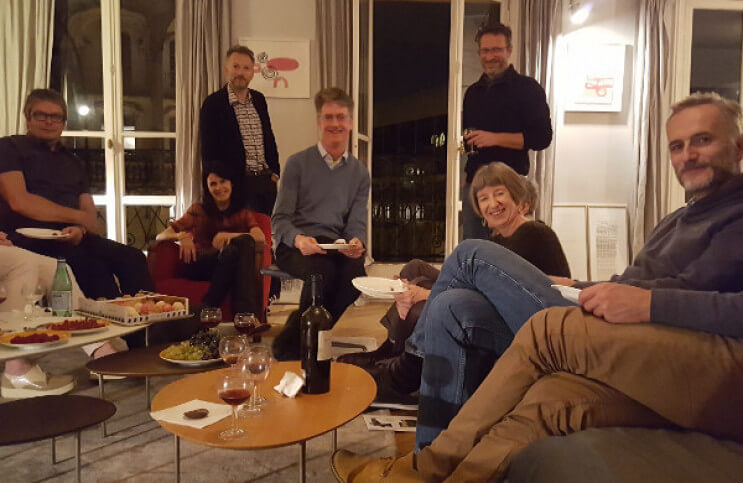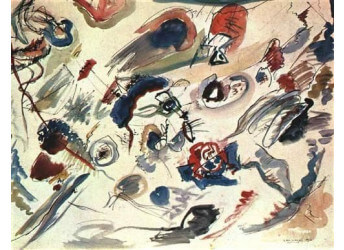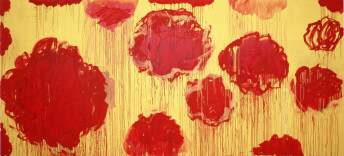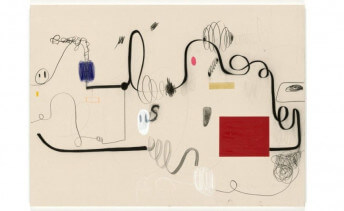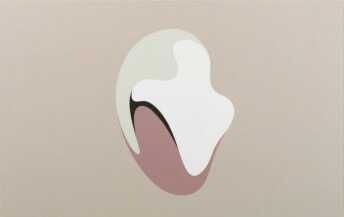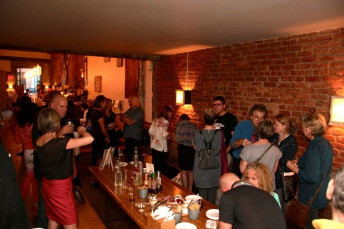A Cocktail of Abstract Thoughts in Paris
Nov 11, 2016
October definitely was the month of contemporary and modern art in Paris. In addition to FIAC (International Contemporary Art Fair, the most famous event) about 30 significant other exhibitions and art fairs blossomed throughout the city, which also has amongst the richest museums in the world. During the month art lovers, collectors and professionals from every nation gathered in the French capital. IdeelArt.com took the opportunity to invite some of them, together with some of its artists, to a traditional French buffet; And guess what? They spoke a bit about wines and a lot about art. Here are some take-aways from the topics which where most discussed.
Why Are Many Exhibitions Dedicated to the Pre-pop Figurative Art This Year?
The three major exhibition centres of Paris, Centre Pompidou (National Modern Art Museum) the MAM Paris (Museum of Modern Art of the City of Paris) and Grand-Palais (main exhibition venue of Paris) are showing art works from René Magritte (a surrealist Belgian painter, 1898-1967), Bernard Buffet (a French expressionist engaged in an anti-abstract group, 1928-1999) and Hergé (the Belgian cartoonist who created Tintin, 1907-1983). In addition, Fondation Louis Vuitton, the two-year-old private museum, in theory dedicated to contemporary art, presents the Chtchoukine collection: 29 Picasso, 22 Matisse, 12 Gauguin and 8 Cézanne amongst other great modern (but not contemporary) masters.
Is it a wave of nostalgia or an uprising of figuration that drive institutions to simultaneously focus on the beginning of modern art and on latter artists which did not accept that abstract art could exist? Probably not… Exhibitions are being prepared years before they are even announced, so in 2013 and 2014 the three major state institutions must have pursued the same aim: being original by celebrating the figurative creation throughout the 20th Century. Unfortunately, by ending up with similar ideas, they somewhat failed to reach the originality that they intended.
Another intent is to rebalance the Parisian scene by offering to the public an art supposed to be less elitist, more accessible and consensual. To that extent early modern art is more popular than contemporary.
Last but not least these institutions are engaged in a fierce competition for the highest number of visitors. For a single exhibition. In 2010, the Grand Palais set the record at 0,9 million with Claude Monet). Pre-pop figuration being accessible to everybody, including primary and high school pupils, exhibiting it is a sure way to boost the number of visitors, maybe not the best, but for sure an efficient one.
Walking through the FIAC and the other fairs across the Champs Elysées (Arts Elysées, 8th Avenue), one cannot oversee that galleries also choose to present more figurative art than in the years before. Abstract painting are numerous but often conceptual, video, installations and minimalism are rarely seen. One IdeelArt artist, who also has a figurative street-art-style activity, said that his gallery only wanted to exhibit his figurative work this year. Another guest, involved in auction sales, sees that as a clue that the market is moving from sellers’ to buyers’ side. Galleries are struggling to make people become collectors and figuration seems easier to recruit new collectors.
Is There No Abstract Art?
How can we deal with Picasso’s formula - there is no abstract art, you must always start with something. Afterward, you can remove all traces of reality?
For sure human brain is full of images and words, and our hands are trained to draw signs, which represent or mean something. Writing about abstraction, Kandinsky, had to draw a parallel with music: according to him abstract visual art was conceivable, the same way as music does not necessarily tell something to the listener. Early abstract works of Kandinsky were frequently named improvisations, compositions or fugues, terms which were new in painting but common in music.
However, like Picasso, many major living painters – such as David Hockney – still believe today that human brain is unable to produce purely abstract pictures and that abstraction results from removing or retaining objective or meaningful items from the surface of the work. In other words, you better be born-blind or non-human to produce genuine non-objective art.
IdeelArt’s artists guests discussed various ways to go beyond objects and meanings.
For Richard van der Aa, a painting is the evidence of a process and, more importantly, an object; the artwork is the residue of a physical activity that has taken place.
 Richard van der Aa - On Things To Come, Enamel on Dibbon, 90x90cm, 2016, Courtesy of the artist
Richard van der Aa - On Things To Come, Enamel on Dibbon, 90x90cm, 2016, Courtesy of the artist
Frédéric Prat conceives the painting as a place surrounded by emptiness where shapes and colours can develop themselves freely; Working horizontally on large canvas helps your eyes and your brain not transferring a meaning or a figure to what is being created.
 Frederic Prat - Blanc 2 2015, Acrylic on canvas, 160 x 130 cm, 2015, copyright Ideelart
Frederic Prat - Blanc 2 2015, Acrylic on canvas, 160 x 130 cm, 2015, copyright Ideelart
Daniel G. Hill creates nets with metal wires and threads then let gravity and mechanical forces shape the forms he has prepared.
 Daniel G. Hill - Sling, Stainless steel wire, 86 x 61 x 38 cm, 2016, Courtesy of the artist
Daniel G. Hill - Sling, Stainless steel wire, 86 x 61 x 38 cm, 2016, Courtesy of the artist
Pierre Auville calls on other forces, using mainly mineral cement, sand, water and… chance in his work; his abstract work is the result of the unpredictable resistance, viscosity and drying process of the material.
 Pierre Auville - Un Dimanche, Cement and pigments on Ursalite panel, 60x104cm, 2014, Copyright Ideelart
Pierre Auville - Un Dimanche, Cement and pigments on Ursalite panel, 60x104cm, 2014, Copyright Ideelart
As already debated in this magazine, there is not – and will never be - a single definition of abstraction. And whether abstract art exists at all or not will likely remain a moot point. What is important is that here are artists calling themselves abstract, and IdeelArt is proud to promote their work, online and globally!
Featured image: From left to right - Richard van der Aa, Christelle Thomas (CEO and Co-Founder of IdeelArt), Pierre Auville, Daniel G. Hill, Frederic Prat, Susan Cantrick, Denis Berthomier, photo Copyright Ideelart
